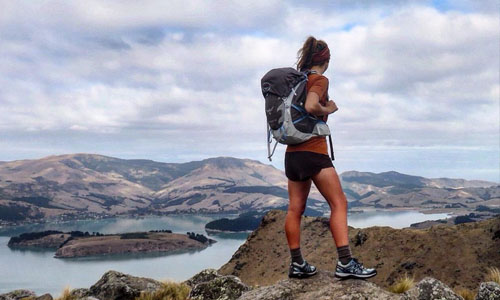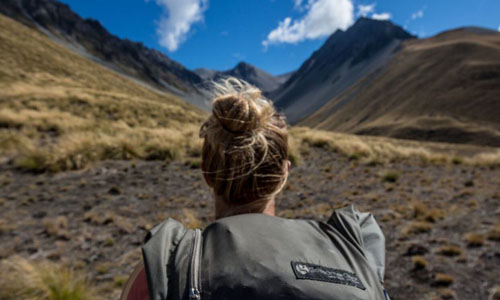Preparing For Your First Thru-Hike
Author

Chris shares his passion for cycling, hiking, skiing, and climbing from Buxton, in the Peak District. As a blogger for Outdoor Look, Chris shares outdoor tips and indoor tricks to help you get the most out of your time spent outside. When he's not out adventuring he's making videos or trying to keep up with his 4-year-old son.
 Thru-hiking is the term we use to describe the Herculean task of hiking a long-distance trail end-to-end within one hiking season. The most popular thru-hike trails like the Appalachian, the Pacific Crest Trail, and the Continental Divide, take an average of five months to complete – so it shouldn’t be surprising when I say that about one in five prospective thru-hikers quit within the first week.
Thru-hiking is the term we use to describe the Herculean task of hiking a long-distance trail end-to-end within one hiking season. The most popular thru-hike trails like the Appalachian, the Pacific Crest Trail, and the Continental Divide, take an average of five months to complete – so it shouldn’t be surprising when I say that about one in five prospective thru-hikers quit within the first week.
Being a backpacker doesn’t necessarily equip you with the requisite skills to make it through the hardships of a long-term end-to-end hike. What helped me go through it successfully (though not easily) was proper planning and training. From taking the right supplies to planning the perfect pit-stops, and how to strengthen your body for the ensuing hardships, everything needs to be planned meticulously to avoid a total shambles.
Prepare your Mind
Being a backpacker and having hiked quite a few times, I had an idea of the kinds of harsh weather conditions I may encounter, but I didn’t quite take into account the fact that it would be happening again and again for months. And after being wet, cold, hungry and extremely tired, I realised that I, like most people, haven’t really gone on backpacking trips in truly bad weather. As dismal as it may seem, you really need to go on a training hike when it’s windy or raining to clearly understand what you are going to face on your thru-hike.
Your Feet are Your Vehicle
Keep in mind that you will be spending nearly five months hiking on changing terrain, and so your feet will take the maximum strain. Make sure that your feet are comfortable in your shoes. Find a bumpy, rocky trail near your home and walk it three times a week to get your feet accustomed to uneven terrain. Try out your shoes, and make sure that the shoes you're going to take on the thru-hike are definitely suitable for the sort of terrain and weather that you will be facing.
Joints are Vulnerable
With uneven terrain and harsh conditions, the chance of getting ankle sprains and knee injuries becomes higher. Add a few squats and lunges to your workout regime in order to strengthen your ankles, knees and core. This will not only reduce the chances of an accidental injury, but it will also reduce the amount of fatigue that you usually experience.
Prepare your Backpack
For a hike that is going to last more than a quarter of the year, you need to make sure that you carry no more than what is absolutely necessary. Pick the lightest and sturdiest equipment available, so that you can carry the required stuff without adding too much to the weight.
Strengthen your Shoulder
On a thru-hike, you will be carrying your backpack on your shoulders for the most part, and so you need to get accustomed to it beforehand. Although you may feel a bit silly, I advise that you start carrying your backpack wherever you go throughout your day – going shopping, on training hikes, even at the office, etc. Start with a small load and keep increasing the weight until you reach your target. It may sound like a painful experience, but ultimately if you can't manage this then you're going to struggle to complete a five-month thru-hike with your backpack weighing down on you.
Prepare for Elevation
Find a hilly trail near your home, and start using a stair trainer or a treadmill with an elevation settings. Increase the elevation setting by 500 feet every week until you hit the 4,000 feet mark. This will help to prepare you for the increased, and often jarring elevations that you will encounter on the trail.
Thru-hikes test your patience and endurance more than anything. Start preparing for the hike at least 8 weeks in advance so that your body can adjust and get accustomed to the challenges you are going to face. Also, pack light, calculate roughly when and where you are going to need to restock on general supplies, do proper research on the trail you are planning to hike, and mark places where you can refill your supplies or get them delivered to you.
Author

Chris shares his passion for cycling, hiking, skiing, and climbing from Buxton, in the Peak District. As a blogger for Outdoor Look, Chris shares outdoor tips and indoor tricks to help you get the most out of your time spent outside. When he's not out adventuring he's making videos or trying to keep up with his 4-year-old son.
- Speed Up Your Post-Hike Recovery with These 6 Essential Tips
- Cycling through Tranquil Roads and Coastal Views on the Isle of Wight
- The Essential Guide to Hiking Safety: 5 Tips Every Hiker Should Know
- Run Smart, Run Strong: Your Guide to Injury-Free Running
- Embrace Biking: Essential Tips for Beginners
Categories
- Sport (28)
- Product Reviews (3)
- Team Outdoor Look (7)
- Mike Wild (2)
- Mike Payton (2)
- Suse Hammond-Pears (3)
- Snowboarding (12)
- Latest Offers (105)
- Shop Talk (1)
- Competitions (7)
- Walking (413)
- Lifestyle Fashion (8)
- Travel (86)
- Kit Guides (176)
- Workwear Clothing (6)
- Safety Workwear (4)
- Health/Fitness (289)
- Skiing (91)
- Great Outdoors (1316)
- Cycling (92)
- January 2025
- December 2024
- November 2024
- October 2024
- September 2024
- August 2024
- July 2024
- June 2024
- May 2024
- April 2024
- March 2024
- February 2024
- January 2024
- December 2023
- November 2023
- October 2023
- September 2023
- August 2023
- July 2023
- June 2023
- May 2023
- April 2023
- March 2023
- February 2023
- January 2023
- December 2022
- November 2022
- October 2022
- September 2022
- August 2022
- July 2022
- June 2022
- May 2022
- April 2022
- March 2022
- February 2022
- January 2022
- December 2021
- November 2021
- October 2021
- September 2021
- August 2021
- July 2021
- June 2021
- May 2021
- April 2021
- March 2021
- February 2021
- January 2021
- December 2020
- November 2020
- October 2020
- September 2020
- August 2020
- July 2020
- June 2020
- May 2020
- April 2020
- March 2020
- February 2020
- January 2020
- December 2019
- November 2019
- October 2019
- September 2019
- August 2019
- July 2019
- June 2019
- May 2019
- April 2019
- March 2019
- February 2019
- January 2019
- December 2018
- November 2018
- October 2018
- September 2018
- August 2018
- July 2018
- June 2018
- May 2018
- April 2018
- March 2018
- February 2018
- January 2018
- December 2017
- November 2017
- October 2017
- September 2017
- August 2017
- July 2017
- June 2017
- May 2017
- April 2017
- March 2017
- February 2017
- January 2017
- December 2016
- November 2016
- October 2016
- September 2016
- August 2016
- July 2016
- June 2016
- May 2016
- April 2016
- March 2016
- February 2016
- January 2016
- December 2015
- November 2015
- October 2015
- September 2015
- August 2015
- July 2015
- June 2015
- May 2015
- April 2015
- March 2015
- February 2015
- January 2015
- December 2014
- November 2014
- October 2014
- September 2014
- August 2014
- July 2014
- June 2014
- May 2014
- April 2014
- March 2014
- February 2014
- January 2014
- December 2013
- November 2013
- October 2013
- September 2013
- August 2013
- July 2013
- June 2013
- May 2013
- April 2013
- March 2013
- February 2013
- January 2013
- December 2012
- November 2012
- October 2012
- September 2012
- August 2012
- July 2012
- June 2012
- May 2012
- April 2012
- March 2012
- February 2012
- January 2012
- December 2011
- November 2011
- October 2011
- September 2011
- August 2011
- May 2010
- April 2010
- March 2010
- February 2010
- January 2010
- November 2009
- October 2009
- September 2009
Submit a Comment